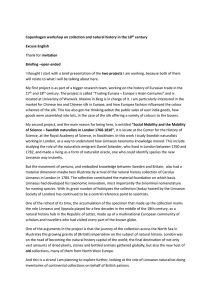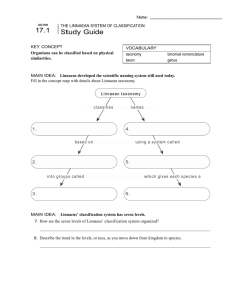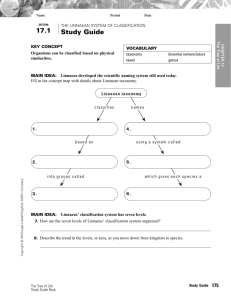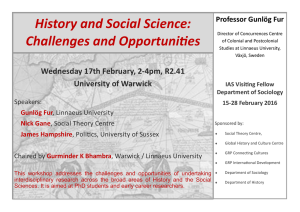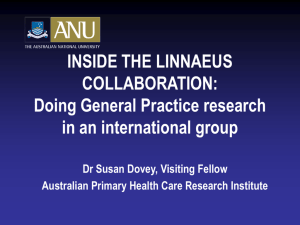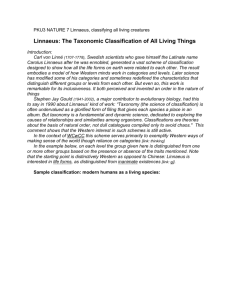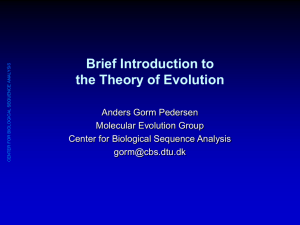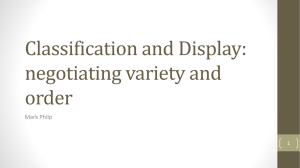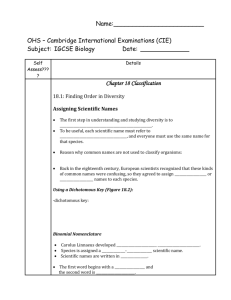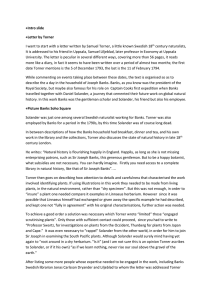Intro As Göran’s paper is an example of, recent discussions of... cameralism and political economy, placing him in a Swedish context.
advertisement
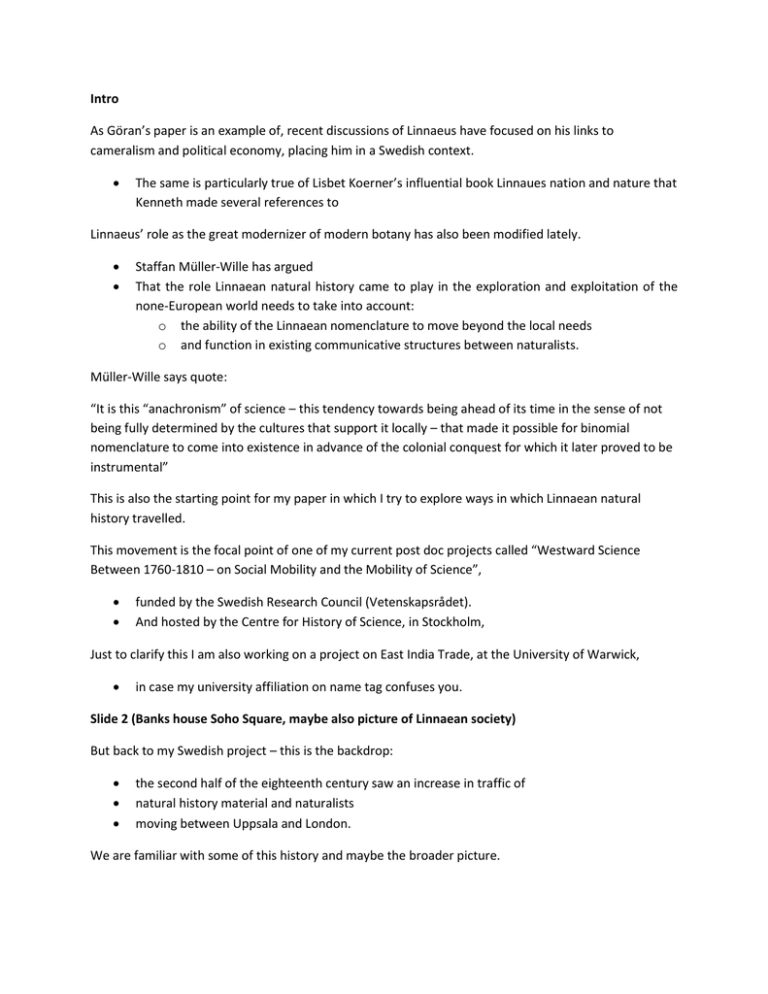
Intro As Göran’s paper is an example of, recent discussions of Linnaeus have focused on his links to cameralism and political economy, placing him in a Swedish context. The same is particularly true of Lisbet Koerner’s influential book Linnaues nation and nature that Kenneth made several references to Linnaeus’ role as the great modernizer of modern botany has also been modified lately. Staffan Müller-Wille has argued That the role Linnaean natural history came to play in the exploration and exploitation of the none-European world needs to take into account: o the ability of the Linnaean nomenclature to move beyond the local needs o and function in existing communicative structures between naturalists. Müller-Wille says quote: “It is this “anachronism” of science – this tendency towards being ahead of its time in the sense of not being fully determined by the cultures that support it locally – that made it possible for binomial nomenclature to come into existence in advance of the colonial conquest for which it later proved to be instrumental” This is also the starting point for my paper in which I try to explore ways in which Linnaean natural history travelled. This movement is the focal point of one of my current post doc projects called “Westward Science Between 1760-1810 – on Social Mobility and the Mobility of Science”, funded by the Swedish Research Council (Vetenskapsrådet). And hosted by the Centre for History of Science, in Stockholm, Just to clarify this I am also working on a project on East India Trade, at the University of Warwick, in case my university affiliation on name tag confuses you. Slide 2 (Banks house Soho Square, maybe also picture of Linnaean society) But back to my Swedish project – this is the backdrop: the second half of the eighteenth century saw an increase in traffic of natural history material and naturalists moving between Uppsala and London. We are familiar with some of this history and maybe the broader picture. o o In 1760 Daniel Solander who was to become a fellow traveller of Joseph Banks onboard the Endeavour, arrived to London. Although originally planning to stay for only a shorter time he stayed here until his death in 1782. Another notable event took place in 1784, when Linnaeus whole collection was shipped over the North Sea. These movements can be said to reflect both the popularity of Linnaean natural history in Britain and a practical need for his taxonomic innovations. London was the centre of an expanding empire, to which a growing amount of new natural history material arrived in growing quantaties. Slide 3 All the names of naturalists What might be less well known is that Solander was just one among several Swedish naturalists who moved between Uppsala and London in the second half of the eighteenth century, In fact, several worked for Banks for extended periods of time. o On the slide is a (not conclusive) record of Swedish naturalists visiting London. My starting point is that these individuals were central in bringing Linnaean nomenclature and taxonomy to Britain and beyond. A study of this group and what they did in London or on British initiated journeys of explorations will contribute to our understanding of how Linnaean natural history became a global science, Slide 4 Picture of Solander, Dryander and Afzelius My discussion is based on material relating primarily to Daniel Solander and Jonas Carlsson Dryander; both of whom worked as Banks’ secretaries. I also touch on the work of Adam Afzelius who used London as a base during the ten years he spent abroad, on leave from his job as “Demonstrator” at the Uppsala Botanical garden. This includes Afzelius work on the west coast of Africa on behalf of the Sierra Leone Company, doing an inventory of the natural history around Free Town Slide 5 picture from excursions Traditionally the movement of natural history knowledge within Europe has been understood in the light of the Republic of Letter. This has produced a rich research tradition looking at how information was exchanged in letters or via print, and how specimen were circulated and collected. Albeit interesting, a mapping of these contacts only gives account for a certain type of knowledge, i.e. knowledge that can be packed up in books, letters and parcels, and travel unaccompanied, between sender and receiver. It does not tell us very much about embodied and lived knowledge, based on experiences from everyday work in different environments, and In the paper that I wrote for the conference I dwelled quite extensively on how Linnaeus designed his taxonomic systems and his nomenclature with his students in mind, creating structures that were easy to remember. I also discuss how this memorised knowledge was put to use, outdoors, on excursions Here I am building some of my arguments on research I did together with Kenneth o on use of the field as a class room in the teaching of natural history This outdoor taxonomic experience enabled Linnaeus’ students to observe and describe less explored landscapes than the fields around Uppsala, with a minimum of assistance in the form of reference books and collections. These were types of embodied knowledges, experiences, and skills that the students had use off, once they left Sweden In my paper I discuss how Afzelius uses this knowledge doing an inventory of the natural history of Sierra Leone. Including how: Afzelius used local collectors, and how his interests in vernacular names of plants, o helped bridge the gap between the local Freetown knowledge and the merging, globally enclosing Linnaean knowledge systems. The documents left from Afzelius’ time in Africa also illustrate his role as a: a preliminary taxonomic authority or agency through whose hands the material first was passed, and whose eyes were first to scrutinise it. Slide 6 Picture of Solander The role as taxonomic authority, able to operate on the fringe of natural history familiar to European scholar and relatively independent of libraries and collections, was one Linnaeus’ students seems to be particularly good at. Solander is another example To paraphrase Edward Dyker, Solander’s biographer, o Solander was the “taxonomic oracle” of London. While Linnaeus still lived it is clear that London naturalists, such as John Ellis, who wrote the book on how to conduct plant transfer we learned about yesterday, thought of Solander as: the extended hears and eyes of Linnaeus. Ellis for example invited Solander as a witness when doing experiments or observation, Solander’s presence confirming or corroborated the correctness of them to Linnaeus. By all accounts, Solander continued to be a stamp of authority also after Linnaeus died, A role probably reinforced by his close relationship with Banks, who from 1779 and onwards was the president of the Royal Society. Dryander (nicknamed “Mr. Dry” by Banks) who replaced Solander as Banks’ naturalist secretary played a similar responding to taxonomic queries with authority guiding other naturlists to books and collections to consult in their work. One can speculate about the extent to which the physical presence and authority of Solander and Dryander in London for such an extensive periods of time (1760-1810), helped to create stability in a time of great changes I suggest we can view them as a form of taxonomic human resource whose work benefitted the smooth running of a natural history centre of growing importance prior to the institutionalisation that took place in the nineteenth century. Slide 7 Linnaeus cabinet There is another dimension to what the Swedish naturalist could offer their London hosts, to do with art of administrating and organising documents and collections. In my paper I here draw on the work of Staffan and Isabelle Charmantier’s on “paper technologies” including for example how Linnaeus by regularly printing new editions of his most important work provided naturalists with updated “annotation platforms” in which they could store information e.g. in the form of observation notes in book margins. Another reference point is Staffan’s work on the cabinet Linnaeus used to store his herbarium in. It had twentyfour shelves, corresponding to the classes in the sexual system, The shelves could be moved a flexible construction that enabled Linnaeus to free up space for expanding classes Intellectual and physical order continued to be important to Linnaeus’ students. As I argued elsewhere, it contributed to the formation of a specific scientific persona in eighteenth century Sweden, An identity which helped the students to continue the work their teacher marked out, although Swedish natural history lost the political support and backup towards the end of the century The organisation of natural history collections formed a reference point on which basis naturalists judged each other’s status and competence, This helped I argue “modern” Linnaean naturalists to distinguish themselves from older “eclectic” collectors. Again I had some examples here about innovative ways in which Linnaeus students organized their collections but I have to leave it due to time restrictions. Slide 8 picture of British Museum and Solander box We can trace a creative and innovative approach to systems and orders in the work of Linnaeus’ students in the rapidly expanding collections of London. Solander is maybe the most prominent example here. Solander was well skilled in the art of organising collections from Sweden, This was an experience he had good use for in London. In his first employment was as an Assistant in the British Museum Here he spend most of the time going over old and new incoming natural history material. The end product of this taxonomic work was several catalogues, In which Solander developed his own system for storing information, using slips of papers. When Solander was working on the catalogues the slips were stored in what today still is known as the “Solander boxe”. This equivalent of the Ward Case Stuart talked about yesterday but for dead material. It is a: o a light but rigid box made from paper or wood designed to protect delicate material, o such as documents or herbarium sheets. Slide 9 Picture of Catalogus bibliothecae historico-naturalis Joseph Banksi After Solander died Dryander took over much of his work in the Banks-household. The recently printed correspondence of Joseph Banks illustrates the role Mr Dry played: Accessing the published work of others. o evaluations often based on their use of Linnaean standards when describing and naming species. But also evaluating other naturalists collections to see if they might be worth purchasing on behalf of Banks or the British Museum Dryander’s knowledge of publication within the sphere of natural history also laid the foundation for one of the few printed works by Dryander: Catalogus bibliothecae historico-naturalis Joseph Banksi, a catalogue over Joseph Banks’ library in five parts published between 1798 and 1800. In other words, Dryander and Solander were central agents in the organising and describing of some of the most prominent natural history collections in in accordance to the principles of Linnaeus. Their identity as Linnaean scholars, and their experiences from collection building in Sweden, informed their work in London. Slide 10 Summary In this paper I have tried to demonstrate that the embodied knowledge and scientific persona of travelling naturalists can give us a complementary history of how Linnaean natural history became a global science. I pointed out that Linnaean taxonomy and nomenclature were designed to be easy to remember. It was also a type of knowledge Linnaeus encouraged his students to test and practice in the field, o away from libraries and collections. With this embodied knowledge advanced students of Linnaeus were very apt at moving around in exotic biotopes at least by European standards, collecting specimen and making available local knowledge to a global (or at least Western) audiences. They could provide the first taxonomic evaluation of species, on the field, their provisional descriptions also promoting a system for delegating work (this is something I dwell on more in the longer paper) The Linnaean naturalists did also play a role in the centre, such as in London, the end station of a growing quantity of globally sourced natural history material the senses of the Linnaean trained naturalists authenticated observations and experiments, their authority created a stability which helped the smooth running of the everyday mapping of the natural history of the world. I also argued that Linnaeus natural history promoted the formation of a specific scientific persona in late eighteenth century Sweden. In London this persona was put to work organising central collections of specimen and books, converting and adapting them along the taxonomic systems of Linnaeus, in new and innovative ways, This, at a time, largely predating the institutionalisation of science. By tracing the traffic along the natural history axis connecting London to Uppsala it is also possible to detect the outline of a geography (more specific than local or global), which also can help explain the process by which Linnaean natural history became a universal science in a none-anachronistic history way.
